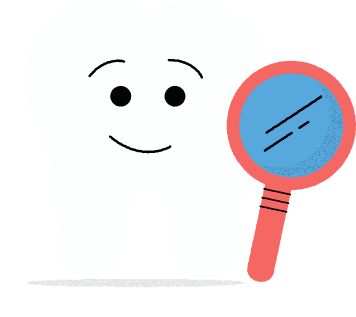If you’re considering braces or are already on your orthodontic journey, you might be wondering: how long will this take? Is there a way to speed things up? The good news is that power chain, which is commonly used on your braces, can help. These tiny but mighty elastic chains add extra force to your braces, helping to quickly close gaps and fine-tune your alignment more efficiently. They are more commonly used for quicker and effective results.
There are many types of power chains and things to know about dental treatment using power chain braces. As a trusted source of advice on orthodontic care, we’re here to help make sense of it all. We’ll offer guidance on how power chains function, their benefits, and how to care for them properly.
What is a power chain on braces?
Similar to the concept of swapping out single paper clips for a paperclip chain, a power chain replaces the individual rubber bands on your braces with a linked chain. So instead of separate elastics holding the wire to each bracket, multiple brackets are held together by the power chain — which applies continuous pressure across the full row of teeth.
Power chains work alongside traditional braces to speed up the movement of your teeth, particularly when closing gaps and improving alignment.
How do power chains help in braces treatment?
There are three main ways that power chains are effective in enhancing orthodontic treatment:
- Closing gaps between teeth, including those created by extractions.
- Aligning teeth more efficiently by applying consistent pressure.
- Reducing overall treatment time in certain cases.
All of these help orthodontists achieve precise tooth movements, ensuring better results for patients especially towards the tail end of their dental alignment treatment
Do power chains work faster than regular braces?
Power chains can speed up the process of closing gaps, but they don’t necessarily make overall treatment significantly shorter. The speed of overall teeth alignment treatment depends on many various factors — the patient’s dental condition, the type of braces used, and how well they adhere to their orthodontist’s recommendations.
While power chains can enhance efficiency, achieving optimal results still requires proper care, regular check-ups, and compliance with orthodontic instructions.
Types of power chains for braces
Power chains come in different types, each designed for specific tooth movements. Like different levels of resistance bands at the gym — some provide stronger force, while others offer more flexibility.
| Types of power chains | Purpose | How it works |
| Closed | Used to quickly close gaps between teeth | Loops are tight with no space; applies strong force |
| Short | Helps guide teeth into better alignment | Small spaces between loops; gives moderate pressure |
| Long | Fine-tunes small movements | Larger gaps between loops; applies gentle pressure |
Experienced orthodontists will be able to choose the right type based on each patient’s needs and treatment plan.
Power chain colours
One of the fun parts of having power chains is that you get to pick the colour! Here are some ideas and why people often choose them.
- Neutral colours like clear, white, or gray are often chosen for a more subtle look. Those working in professional corporate settings might prefer this as it suits a more professional, clean look.
- Bold colours such as blue, green, red, or purple give a vibrant appearance. Many creative professionals, students, and kids enjoy experimenting with colours to represent their personality.
- Dark colours — black or navy, are usually chosen for more practical reasons like minimising staining from food or coffee.
You can switch up colours at each orthodontist visit, making your braces as stylish (or discreet) as you want.
The side effects of power chains
While power chains are highly effective, it’s important to know that they may cause some mild discomfort initially — but it gets better with time. You might experience some of these common side effects:
- Soreness and sensitivity: You may feel pressure for a few days after they’re applied or adjusted.
- Gum sensitivity: Some people experience mild irritation around the gums.
- Staining: Light-coloured power chains can stain from certain foods and drinks
These side effects are temporary and manageable with good oral care. Keep your orthodontist updated on how you’re feeling so they can monitor your progress. Also learn more about what to expect when you wear braces.
How to care for and maintain power chain braces
Being a wearer of power chain braces does come with the responsibility of taking special care of them. It isn’t complicated, but it does require consistency. Here are some ways to keep your teeth and braces in top shape:
- Maintain good oral hygiene: Plaque loves to hide around brackets and power chains, so it’s important to brush and floss daily after every meal. Poor hygiene can lead to plaque build up and increase the risk of gum disease.
- Use a floss threader or water flosser: These specialised teeth cleaning tools help reach areas that your toothbrush can’t — make cleaning between braces more effective. Interdental Brushes are also good to have on hand for removing food particles from tricky spots.
- Rinse with fluoride mouthwash: fluoride mouthwash helps keep enamel strong and prevents cavities.
- Watch what you eat: Avoid hard and sticky foods — nuts, ice, caramel, and chewing gum — can break your power chains and brackets, setting back your progress.
- Keep regular dental check-ups: Regular orthodontic visits ensure your treatment stays on track and adjustments are made as needed.
Learn how to care for your braces here.
Consult a registered specialist orthodontist
Power chain braces are a great tool for achieving a straighter smile, helping to close gaps and fine-tune alignment. But as with any orthodontic treatment, expert guidance is key.
If you have questions about power chains or braces in general, book a consultation with an specialist orthodontist. They’ll help you understand your options and guide you toward the best treatment plan for your smile. Find a trusted orthodontist here.
Meanwhile, learn more about what to expect before and after braces.
FAQs
-
What does a power chain do for braces?
A power chain helps move teeth more efficiently by applying continuous pressure across multiple brackets. It’s commonly used to close gaps, improve alignment, and fine-tune the final stages of orthodontic treatment. By working alongside traditional braces, power chains can enhance the overall effectiveness of tooth movement. In some cases, they can reduce overall treatment time by accelerating tooth movement.
-
Power chains vs other orthodontic tools?
Unlike individual elastics or metal ties that secure each bracket separately, power chains connect multiple brackets to apply continuous pressure. This makes them more effective at closing gaps and ensuring even movement across multiple teeth. They work in tandem with braces to improve efficiency but are not a replacement for other orthodontic tools.
-
Why do power chain braces hurt?
When power chains are first applied or adjusted, they increase pressure on the teeth, leading to temporary soreness. This discomfort is a normal part of the orthodontic process as the teeth shift into their new positions. The pain typically subsides within a few days as the mouth adjusts.
-
How do I manage pain and discomfort from power chain braces?
To ease discomfort, try eating soft foods, taking over-the-counter pain relief, or using orthodontic wax if needed. Cold foods like ice cream or smoothies can help numb soreness, while warm saltwater rinses can reduce gum irritation. Most discomfort fades within a few days, but if pain persists, consult your orthodontist.
-
How long do power chains stay on braces?
The length of time a power chain stays on braces depends on your specific treatment needs and how quickly your teeth respond. Some patients wear them for a few weeks, while others may need them for several months. Your orthodontist will monitor your progress and adjust the power chain as needed.
-
What are the side effects of the power chain?
Power chains can cause temporary discomfort, as they apply extra pressure to move teeth. Common side effects include mild gum sensitivity, slight swelling, and difficulty eating harder foods in the first few days. Over time, power chains may also stain from certain foods and drinks, but proper oral hygiene can help minimise discoloration.









